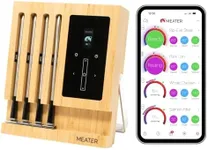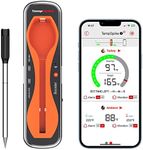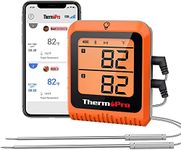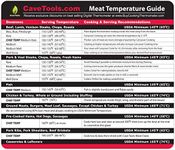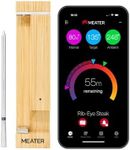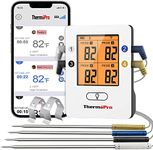Buying Guide for the Best Wifi Meat Thermometer
Choosing a WiFi meat thermometer can make cooking much easier and more precise, especially if you like to monitor your food remotely or want to ensure perfect results every time. The right thermometer will help you keep track of your food’s temperature without having to constantly check it, giving you more freedom and confidence in the kitchen or at the grill. To find the best fit, it’s important to understand the main features and how they relate to your cooking habits.WiFi ConnectivityWiFi connectivity allows your thermometer to send temperature readings to your smartphone or tablet, even if you’re not right next to the grill or oven. This is important because it gives you the flexibility to move around your home while still keeping an eye on your food. Some thermometers only work with Bluetooth, which limits your range, while WiFi models can work anywhere your home network reaches. If you want to monitor your cooking from anywhere in your house or even outside, look for a model with strong and reliable WiFi capabilities.
Number of ProbesThe number of probes determines how many different pieces of meat or areas you can monitor at once. This is important if you often cook for a group or like to prepare different types of meat at the same time. Basic models may have one or two probes, which is enough for simple meals or small gatherings. More advanced models can have four or more probes, which is great for larger meals or if you want to track both the meat and the ambient temperature inside your grill or oven. Think about how many items you usually cook at once to decide how many probes you need.
Temperature Range and AccuracyThe temperature range tells you how hot or cold the thermometer can measure, and accuracy shows how close the readings are to the real temperature. This is important because different meats and cooking styles require different temperatures, and you want to be sure your food is cooked safely and to your liking. Most home cooks will be fine with a range that covers from about 32°F to 572°F (0°C to 300°C), but if you do high-heat grilling or low-and-slow smoking, check that the thermometer can handle those extremes. Accuracy within 1-2 degrees is usually good enough for most uses.
App Features and AlertsThe companion app is what you’ll use to monitor your thermometer remotely, so its features and ease of use are important. Good apps let you set custom temperature alerts, timers, and may even offer cooking guides or recipes. Some apps can send notifications to your phone when your food reaches the target temperature or if the connection is lost. If you like having extra help or want to avoid overcooking, look for a thermometer with a well-reviewed, user-friendly app that offers the features you care about.
Battery Life and Power OptionsBattery life determines how long you can use the thermometer before needing to recharge or replace batteries. This is important for long cooks, like smoking brisket, where you don’t want the thermometer to die halfway through. Some models use rechargeable batteries, while others use standard AA or AAA batteries. If you often do long cooking sessions, look for a thermometer with a long battery life or one that can be used while charging. Consider how often you cook and how long your sessions usually last to pick the right power option.
Build Quality and Probe DurabilityThe build quality of the thermometer and its probes affects how long it will last and how well it stands up to heat, moisture, and frequent use. Probes should be made from food-safe stainless steel and be able to handle high temperatures without breaking or losing accuracy. The main unit should be sturdy and, if you cook outdoors, possibly weather-resistant. If you cook often or in tough conditions, prioritize a model known for its durability and strong build.
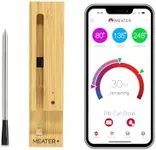
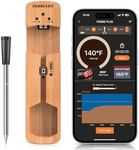
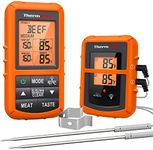
![MEATER SE [New]: Wireless Smart Blu](https://images-proxy.bestreviews.guide/I8E-cJIaYR2IpEgfCGbO9DKTenQ=/0x150/https://m.media-amazon.com/images/I/31pyK4OzeGL._AC_CX679_.jpg)
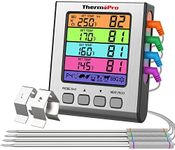
![MEATER Pro XL [New] - Wireless Smar](https://images-proxy.bestreviews.guide/xpkVEoWsvsZ1rE8CdKW2W_vq0uk=/0x150/https://m.media-amazon.com/images/I/41OZr5kVJlL._AC_CX679_.jpg)
